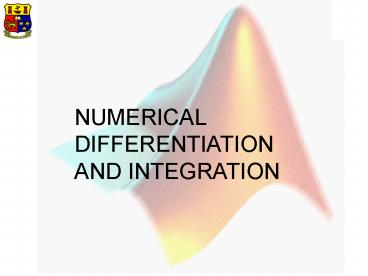Diff and Int PowerPoint PPT Presentation
1 / 30
Title: Diff and Int
1
NUMERICAL DIFFERENTIATION AND INTEGRATION
2
Numerical Differentiation
Methods of finding a derivative
- Analytic methods
- requires hard work
- produces exact answer
- not always possible
- Symbolic methods
- computer does hard work
- produces exact answer
- not always possible
- Numerical methods
- computer does the hard work
- produces approximate answer
- always possible
3
Gradient
4
Gradient at a Point
Y
(a, f(a))
X
f ?(a) the gradient (slope) at the point x.
5
Gradient at a Point-cont.
Q
slope
f (a h) f (a)
h
P
6
Instantaneous Rate of Change
Q
f (a h) f (a)
h
P
Let h approach 0
7
Forward Approximation
Approximate f ?(x) by using forward differences
Use chord joining x to (x h, f(xh)) , h
should be very small
8
Backward Approximation
Approximate f ?(x) by using backward differences
Use chord joining (x - h, f(x-h)) to x , h
should be very small
9
Central Approximation
Approximate f ?(x) by using central differences
Use chord joining (x - h, f(x-h)) to (x h,
f(xh)) ,h should be very small
10
Summary
x
x h
x - h
X
11
Taylor Series
Which Approximation is Best to Use?
- Taylor series expansion of a function f(x) at
point x close to point a
12
Taylor Series
Find f(b) given f(a)
13
Taylor Series
Find f(b)
- Using two terms
14
Taylor Series
Find f(b)
- Using three terms
15
Error in Truncating Taylor Series
- If we truncate the series after the nth term, the
error will be
- For example, if we truncate after the 3rd term
16
Forward First Derivative
- Consider the Taylor series expansion of f(x)
near a point x
Solve for
Truncate here
First order approximation of first derivative
17
Backward Central First Derivative
Instead of f(xh), now expand f(x-h) to get the
backward difference formula
Subtract f(x-h) expansion from f(xh) expansion
to get the central difference formula
The central approximation should always be best.
Why?
Error of the order of h2
18
The Second Derivative
19
Another Way of Writing these Formulae (the first
derivatives)
- Forward difference formula
- Backward difference formula
- Central difference formula
20
The Partial Derivatives
- Partial derivative of a function of two variables
- General point as (xi, yj )
- The value of the function u(x, y) at that point
as ui, j - The spacing in the x and y directions is the
same, h - Using subscripts to indicate partial
differentiation
21
The Partial Derivatives
- For the mixed second partial derivative and
higher derivatives, the schematic form is
especially convenient. - The Laplacian operator
- The bi-harmonic operator
22
Numerical Integration
Finding Areas Numerically
23
Finding Areas Numerically
The basic idea is to divide the x-axis into
equally spaced divisions as shown and to complete
the top of these strips of area in some way so
that we can calculate the area by adding up these
strips.
24
Finding Areas Numerically
The first way is to complete the strips as
shown. We are then adding up rectangles of height
and width . In this case the area is ? Note that
the last y-value is not used.
25
Finding Areas Numerically
The Trapezium (Trapezoidal) rule Complete the
strips to get trapezia. Add up areas of the form
a
b
26
Finding Areas Numerically
Simpsons Rule We complete the tops of the
strips as shown with parabolas.
27
Examples
Rectangle
Trapezium
Simpson
28
Choosing the Step Size h
h(a-b)/n
Choose large n to reduce errors
Trapezoidal Rule
Similarly for Simpson's Rule
n1 n2
n3
n4 n20
n100
29
Merits and Demerits
- Trapezoidal rule
- advantages
- there can be any number of data points
- the data points can be arbitrarily spaced
- disadvantages
- the error only reduces proportionally to the data
spacing
- Simpsons rule
- advantages
- the error reduces proportionally to the square of
the data spacing - disadvantages
- there must be an odd number of data points
- the data points must be evenly spaced
30
In the next lecture we will look in more detail
on these and some more methods of numerical
integration

